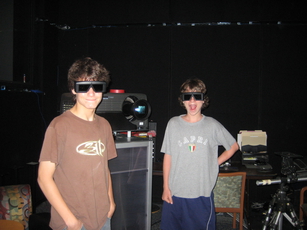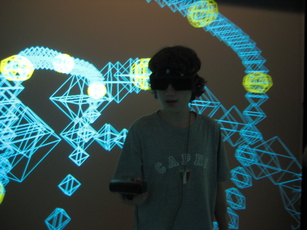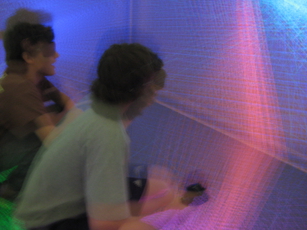Copyright © 2010 Joseph Mack
v20101228, released under GPL-v3.
Abstract
My high school computing class visits the DIVE.
Material/images from this webpage may be used, as long as credit is given to the author, and the url of this webpage is included as a reference.
Table of Contents
I've attended a couple of summer courses in Alice (http://www.alice.org/) at Duke University, taught by Susan Rodger (http://www.cs.duke.edu/~rodger) and her students. As well as learning Alice, I get to talk to high school teachers about teaching computing.
One of my python students, Austin, also attended one of Susan's courses, finding Alice easy enough to learn, that he is still using it 2yrs later for homework assignments. Both of us got to know the very helpful Henry Qin, a student assisting at the Alice courses.
In summer 2009, at the end of the school year, Henry took my python class, Zander Moss, Austin Mack and me, on a tour of the DIVE (http://vis.duke.edu/dive/) a CAVE at Duke University. A CAVE (computer aided virtual environment) is a 3-D virtual reality box. The CAVE at Duke had to have a "D" in it, so it's called the "DIVE" (Duke Immersive Virtual Environment). It's a 6m cube in which the 6 sides have the 3-D enviroment projected in realtime. Since the floor is a screen, you wear special slippers.
The viewing cube is in a dark cavernous room filled with hardware (computers, projectors, speakers).
One person has the tracker, the handheld device which controls the simulation. The view is generated from the perspective of the tracker, so you want to stand close to the person with the tracker or else objects lean to one side. As part of the demos, a computer generated person is put into the center of the room with you. Everyone has 3-D glasses.
I'd been in the DIVE before. You're warned that people can feel nauseated because your eyes tell you that your body is doing one thing (flying through space at a great speed), while your stomach tells you that you're doing something else (nothing).
In my previous trip I'd jumped off a wooden plank into a volcanoe. You drop through a long shaft, while watching the walls of the shaft fly by. From the floor below, a dot of light expands to become a room when you hit bottom. This was a real hoot the first couple of times, till I realised I was nauseated. I still felt that way that night when I went to bed, but by morning I'd recovered.
For the kid's field trip I warned them of the side effects, and for myself decided to look away whenever the scenery was moving too fast.
We took a P&S shoot camera for the record. The camera sees both 3-D images at once, so what you see in the photos is not what you see in the DIVE with 3-D glasses. We saw 4 demos at the DIVE; the one that impressed the kids the most was the roller coaster at the end and this is the only one I have any images of.
The first demo was the volcanoe and the kids jumped into it quite happily without any stomach repercussions. I looked away as the walls of the shaft wizzed by.
The 2nd demo was the most impressive to me. It was a 3-D reconstruction of Solomon's Temple. You can walk around it, through it and hover over it. This was a year long project by a classics student working with a computer student.
The 3rd demo was a squash-like game with a virtual paddle and ball.
The 4th demo was a roller coaster. The kids initialise the coaster by pointing and clicking to generate roller coaster's nodes in 3-space. The computer threads a roller coaster through the nodes and then starts the ride. One student had a grand old time, but the other one's stomach was a little worse for the wear at the end of the demo.


